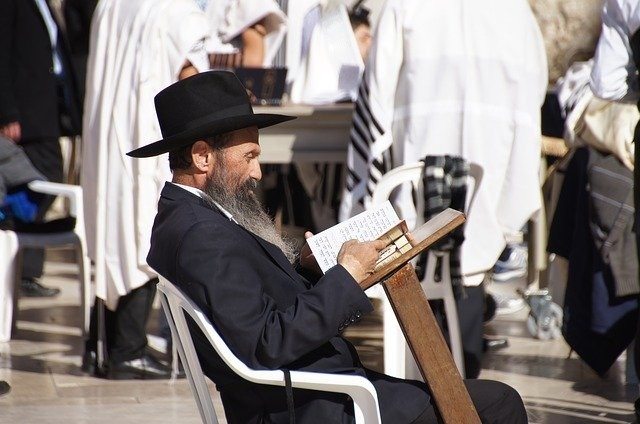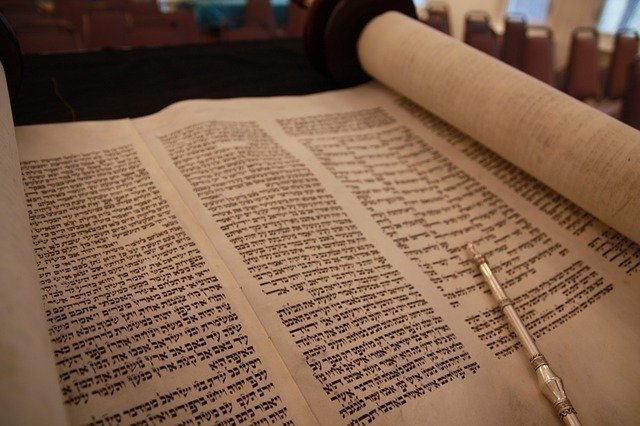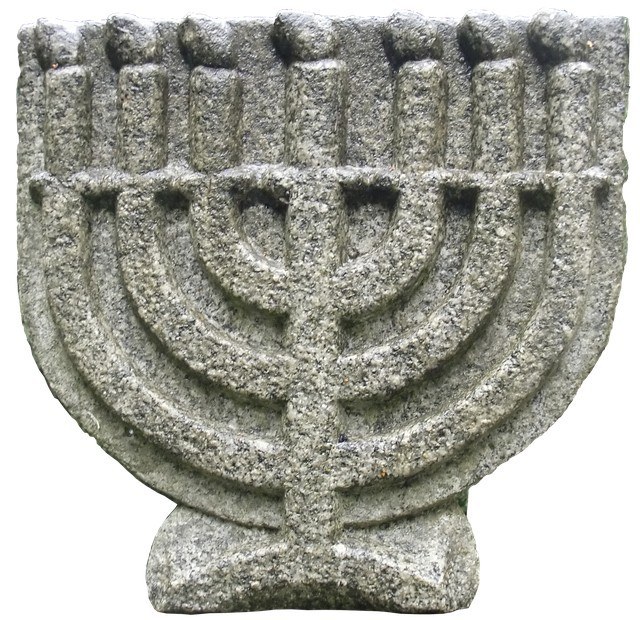
‘Orthodox’ is taken from the Greek word orthos meaning “straight or correct” and secondly doxa meaning opinion, and thus we may say that Orthodox Judaism follows a strict set of rules as interpreted from the Talmud and other rabbinical traditions. It should be noted that another term, Torah Judaism, is how many Orthodox followers prefer to be referenced, as Orthodox is a more modern interpretive title for their faith.
This form of Judaism is very different from more contemporary styles of Judaism, such as secular, reform or conservative Judaism, but does have some offshoots in Modern and Haredi Judaism branches under the Orthodox arm of this religion that differ slightly in the interpretation and practice in key areas. To more fully understand orthodox Judaism beliefs and practices, let’s take a quick look at some of the overarching beliefs of this group.
Daily Prayer Requirements
Orthodox Jewish men pray a minimum of three times daily and believe that this activity today corresponds directly to sacrifices made in ancient times in the Temple. Upon the Temple’s destruction, the Jewish faithful found a biblical substitute from Psalms, which says, “Let my prayer be counted as incense before you, and the lifting up of my hands as the evening sacrifice.”
As they could no longer offer sacrifices as required by God as atonement for their sins without the Temple in which to do so, the daily requirement of prayer took its place for Orthodox Jews. The most devout pray throughout the day, using numerous Psalms and recitations from a variety of Holy Texts. In addition to their Pray requirement, what other Orthodox Judaism beliefs and practices are there of note?
[If you want to get more involved with the original Hebrew culture, read here my article on this subject.]
Study of Religious Texts
Orthodox Jews believe that the Torah, as it was handed down to Moses from God, is unalterable and, as such, along with the Oral Law all now held within the Talmud is the Holy Text of most note to provide direction for all aspects of their lives. Daily contemplation of these texts and other Holy interpretations and arguments help draw the user closer to God and understand his Mitzvahs more fully.
Interesting to note is that there is no overarching governing and unifying Orthodox body, with a set of Orthodox principles of faith, which leaves much of this still up to a bit of personal or group interpretation. It is due to this that a strong personal examination of Scriptures may lead to slight differences in personal belief systems. The unity comes in belief that the answers can always be found in the Talmud but allows for some differences in how that text might be implemented in our modern age.
In this vein, Haredi Judaism believers amongst Orthodox Jews believe that any criticism or divergence from the Talmud to be in opposition to their faith. While the Modern Orthodox followers believe that revisiting, arguments, and study on this subject, which may lead to changes in beliefs, is acceptable.
Though they may disagree in how they exercise their options after reading the texts, notice the main theme that a study of religious texts is never in question, just what you do with said information afterward.
Ablution Ritual(s)

Ablution is also known as ritual washing, and while many Jews of more modern belief systems find these along with other rituals outdated and no longer practice them, Orthodox Jews still may follow some or all the requirements. These rituals came from Traditional Judaism beliefs, that were interpreted and practiced in the temple as it related to uncleanliness, and many of the practices still hold relevance today in the fact that it is a removal of impurities, but might not hold the same ritualistic format.
For instance, Netilat Yadayim done with a blessing prior to eating any bread with a meal; Netilat Yadayim rinsing one’s hands after rising from a nap or sleep, when converting to Judaism faith and the list goes on. Many of these customs are still practiced in Orthodox Jewish homes today, but the level again of ritual or exceptions that they allow are interpretive at best and will show variances in execution.
Gender Segregation
In Orthodox synagogues during prayer services seating for men and women is segregated, keeping with tradition steeped again in the Torah, in which it says that a man who spends a lot of time speaking with women, including his wife, is not enough focused on the study of Torah and will inherit gehinnom or a place reserved for the wicked.
Thus, this separation is believed to allow a man’s full attention on the service to God at hand and not get him distracted. A mechitza or partition between men and women not allowing gazes and impure thoughts to become a distraction is a tradition found all the way back in the Sukkot festivities documented at the Jerusalem Temple.
This separation at the highest level is thought to cut down on the mixing of the sexes and any sexual promiscuity. Additionally, of note, is that Rabbinic Law at one time, only allowed the central areas of synagogues to be entered by men, and that same law bound men to the requirements of daily communal prayer.
Like many aspects of Orthodox Judaism, the extent to which this separation occurs in the synagogue appears to be varied, and decided by the synagogue or members themselves but can be impacted by governing bodies if one exists in the area. This separation thought does go directly toward another aspect of Orthodox Judaism beliefs and practices: modest dress.
Modest Dress Code
The modest dress code requirement that is part of the Orthodox Jews belief system is rooted in the Torah requirement for modesty. This requirement is most important to Jewish women, that tend to wear looser, dark clothes with sleeves at least to the elbow and skirts covering their knees.
Married women may even cover their hair as a sign they are no longer available. There are no such strict requirements for the men, though there seems to be in most Orthodox communities a similar modest requirement exercised for the men. One such story that emphasizes this requirement of the Talmud is that of Kimchis, who had seven sons, all who served as high priests.
When asked how she had accomplished such a great honor, she was reported to have said that she managed to do this by never exposing her hair, not even in her own home. This modest trend does continue, but all allows for more colorful or special clothing for the Jewish woman and man on the occasion of Shabbat or festivals, which helps make these occasions stand out in their celebration.
The modest dress code, much like the separation of the genders at synagogues, goes to not putting impure thoughts into the minds of those looking upon an immodest person. This helps curb improprieties and shows the extent of a person’s devotion to God and his rules to stay pure to him.
Many Orthodox Jews today have learned to blend into their environments and will dress in a manner consistent with the area in which they live. Even when bending some of the more traditional dress rules, many will adhere to the modesty factor in ensuring shorts and skirts not too short, tops not overly tight or sleeveless, and the like.
Kosher Dietary Restrictions

Since the Torah was placed in Moses’s hand on Mount Sinai, food requirements have been part of the law passed down for generations. Orthodox Jews still live by Kosher food requirements which include:
- Certain animals such as pigs, shellfish, reptiles, etc. cannot be eaten at all.
- Split hoove animals such as cows, sheep, etc. are kosher.
- How the animal is sacrificed and drained of blood is critical to defining it kosher.
- Generally, birds of prey are not considered kosher.
- Eggs need to be from kosher animals, and checked to be free of blood in any amount as that is not kosher.
- Meat cannot be eaten with dairy.
- Fish should have fins and scales removed before eating.
- Fruits and vegetables free of any bug infestation are kosher.
- Grape products, including juice and wines, need to be produced by Jews to be kosher.
- And other such requirements.
Today Orthodox Jews have an easier time finding and identifying kosher foods due to new processing and labeling requirements. Due to mass production of food, these requirements, much like vegan items, gluten-free, etc. are strictly regulated by governments as it is more difficult to grow and control food sources, though some strict Orthodox may still show within smaller communities to do just this. Food requirements to be kosher are still a staple of most Orthodox Jewish communities, but as with all areas of the Orthodox faith, there are some variances in adherence to kosher requirements.
Sexual Cleanliness
This one should by now be evident after separation of women and men in worship and modest dress, that sexual cleanliness with roots obvious in the Mitzvahs provided by Moses to this day was essential. This can extend not just to having relations with someone to whom you are not married, to marital relations that were prohibited after a woman experienced her menstrual cycle, and went through a ritual bath.
Family purity in the Jewish faith is not about abstinence but about ensuring the correct partner for a solid faithful life and encourages a happy fulfilling sexual relationship with said partner as God has told us he ordained and approves.
While some who say that Jews try to minimize their pleasure in this area or believe in staid and old-fashioned abstinence in relationships for a variety of reasons are not understanding this requirement entirely. It is about ensuring the sanctity of this part of life, while not detracting from the study and exercise of religious purity in their life.
This area, as we would expect, has a lot of modern interpretations also and can vary drastically in modern acceptance and practice. Finally, probably the most important question regarding Orthodox Jewish beliefs and practices is their separation from the rest of the world at large, and what are the modern beliefs on this topic?
Interactions with the World at Large
Guess what – this can vary greatly among Orthodox Jews. Some communities may remain extremely traditional down to only speaking Yiddish or Hebrew, and others intermingle in roles throughout secular jobs, socializing with those outside their community and behaving in other non-traditional ways.
Many of the most ultra-Orthodox will have attended university and are highly educated, and yet shy away day to day from modern conveniences such as televisions, computers and cell phones. While other families encourage the young to go to mainstream higher education schools and contribute for the better in all manner to the world around them, as role models of their religious upbringings.
Most Jews are extremely family-oriented and maintain strong ties with their families, and honoring parents remains a tenet of their belief system.
While most do have a strong Jewish ancestral identity that is important to them, sharing that with and marrying that foundation with the secular world has become more common in this modern age of the Orthodox Jew. While this mingling is more acceptable, one aspect that has garnered slower acceptance and is still heavily frowned upon is marriage to an outsider or nonbeliever.
Thus, from traditions started in the moment God handed down the Mitzvahs to Moses, the basis of Orthodox Judaism’s oral laws of old married with this written version. The traditions, interpretations and adherence to these rules is governed by a rule of strong biblical study in the Jewish faith.
This study allows for some interpretation which sees slight variations in adherence to such things as external interactions with secular world, bathing rituals and even separation of the sexes in the synagogue.
What doesn’t change is the conversations in the Orthodox Jewish communities around the Torah and other texts and their relevance in this modern world – and maybe it is keeping those conversations alive. That is the clearest similarity through all Orthodox Judaism.